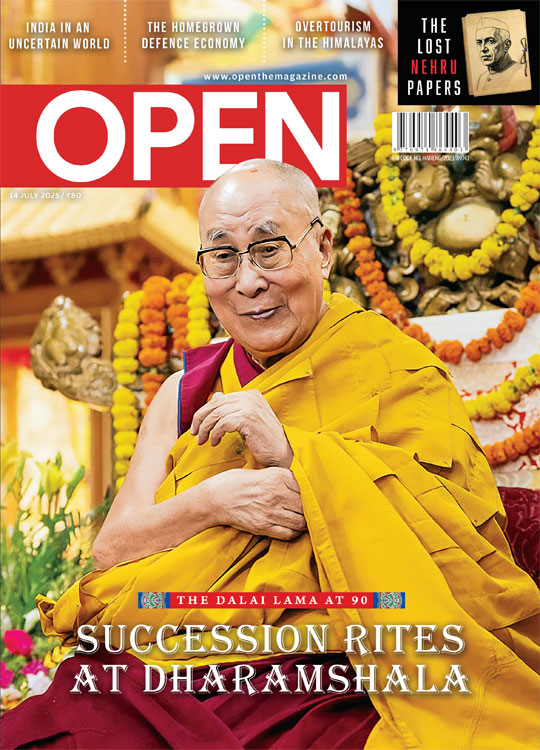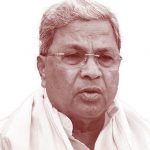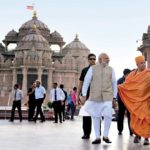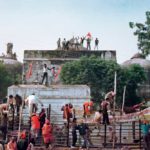Dateline History
The operative emotion here is one of longing—for better work, opportunities, some development, and, of course, for the grand temple. The contrast with intellectual India could not be more different
 Siddharth Singh
Siddharth Singh
 Siddharth Singh
Siddharth Singh
 |
30 Nov, 2017
|
30 Nov, 2017
/wp-content/uploads/2017/11/Datelinehistory1.jpg)
FOR A MAN at the threshold of his eighties, Nritya Gopal Das has a stentorian voice and a commanding presence. The leader of the Ram Janmabhoomi Nyas, an organisation spearheading the Rama temple movement, exudes confidence and fields questions from TV journalists with the ease of man who knows what he is saying. He should, for after the 2003 death of his senior, Ramchandra Paramhans, he has been among the topmost religious leaders who have kept the agitation going even in its quiescent phase.
One BJP Government completed a full term in 2004 and another is into its fourth year, and there is no sign of the temple being constructed so far. But this has not dampened Gopal Das’ spirits. “(Narendra) Modi and Yogi (Adityanath) are both in power. If the temple will be built, it will be built now, during their term in office, or it will never be,” he says, speaking in his meeting room tucked away in a bylane of Maniramdas Chhavani in Ayodhya. He is quick to add that he is confident the construction will be carried out.
This sentiment is a far cry from the heady days of the early 1990s. At that time, there was a groundswell in favour of the temple and activists poured in from across India, bearing bricks etched with ‘Shri Rama’ in a multitude of languages spoken in the country. When December 6th, 1992, came, the combination of activists and a prime minister who allegedly harboured ‘Hindu wishes’ proved irresistible. The mosque vanished, but 25 years later, the temple is yet to materialise.
The bricks can be seen in neat piles at the workshop of the Nyas barely a kilometre as the crow flies from the janmabhoomi site. Of the 212 pillars of sandstone needed for the ‘grand temple’, 106 are piled around haphazardly. Most bear shades of black after long exposure to the elements. There are just two craftsmen at the site who silently chip away at a blank pillar. “A lot depends on what happens in the court. If the remaining 106 pillars are to be carved fast, we need anywhere from 500 to 1,000 skilled artisans. Even then, the job may take anywhere up to five years,” says one craftsman. Hailing from Gujarat, he says the pace of the work is somnolent and the two supervisors assigned to watch over it have gone home for the time being. The architect has not visited the place in a long time.
All this offers a sharp contrast to the fevered debates in places like Delhi where speculation surfaces every now and then about a quickening pace of work at the temple’s karyashala in Ayodhya. The sleepy workshop is just a metaphor; it is as if the entire town is caught in a time warp. From the northern edges of the town, near the Swargdwar locality—from where Lord Rama is supposed to have left for heaven at the end of his earthly reign—to many buildings on its main thoroughfare, Ayodhya is a crumbling spectacle. In any case, no one remembers the significance of Swargdwar or other localities. There is a plenitude of temples, but history, it seems, has been abandoned. It is strange to hear hymns emanating from every street one passes and see muck all around at the same time. Except the environs of the temple’s proposed site, where there are some fine preserved buildings, little investment seems to have been made in Ayodhya. It is somewhat ironic that the most imposing structure in the town is a clock tower erected by the British in 1900.
The physical decay in what is no more than an overgrown 19th century village is matched by the quiet despair of its residents. Some chase tourists for work as guides; others long for a temple at the janmabhoomi, hoping for benediction at the hands of Lord Rama.
Close to the junction of the janmabhoomi compound’s exit and the road leading to Hanumangarhi, Keshavram Mishra runs an open kitchen for visitors. “There is no question about it. There was a temple in the past and another one will be built here. It is incumbent on us to rebuild it if this city is to gain the blessings of the Lord,” he says. For a cynical observer, his words can sound rather naïve, apparently ignorant of the issue’s complexities. What about Yogi Adityanath, can he do something about speeding up the process? “Yogiji is a man with good intentions, but I doubt if he is up to the job. Yes, we have lot of faith in Prime Minister Modi, but what can a single man do in handling a country of 125 crore people?”
“Narendra Modi and Yogi Adityanath are both in power. If the temple will be built, it will be built now, during their term in office, or it will never be” – Nritya Gopal Das, president, Ram Janmabhoomi Nyas
Perhaps all this is to belabour the point. After all, small town India leads an equally uncertain life, so why claim a difference for Ayodhya? The people of the city claim no such distinction for themselves. If anything, the operative emotion here is one of longing—for better work, opportunities, some development, and, of course, for the grand temple. The contrast with intellectual India could not be more stark. In the salons, universities, courts and seminar rooms of India’s big towns, the expression ‘Ayodhya’ evokes a different set of emotions that range from alarm to contempt, the latter mostly left unexpressed but one that is all too visible, given the tell-tale signs.
By the early 1990s when it became impossible to ignore the fervour for a Rama temple among Hindus, ad hoc theorising on the phenomenon began in earnest. This gained momentum after the 1992 demolition of the mosque. One of the earliest such theories was the anxiety thesis. It was a simple stitching together of events of the recent past, from the 1981 Meenakshipuram conversions to the 1986 legislative dilution of the Shah Bano judgment. As a first shot at theorising, anxiety did seem like a compelling argument for that time, even if extending a psychological explanation to the mass level raised more questions than answers.
AS IT OFTEN happens, the theories come after the event. Systematic analysis began well after the BJP’s first full term in office ended in 2004. There is now a clutch of closely linked theories that range from Hindu anxiety to comparative analysis of the Indian landscape, extending the roots of ‘Hindutva’ all the way to the colonial period. Most of this work has been penned by scholars outside India. Nearly two decades after Ashutosh Varshney sketched the idea of Hindu anxiety, Perry Anderson lifted it to the comparative realm when he clubbed India with Ireland and Israel in a bilious book. Three years later, in a calm work, Michael Walzer, a political theorist endowed with a far more sympathetic understanding of religion and politics, left Ireland out of the picture and added Algeria to the comparison mix.
The shifts in geographic gears notwithstanding, the two works display a certain similarity. If both scholars displayed anxiety at the recrudescence of religion in politics, their emphasis, tone and origin of what they sought to explain was very different. For Walzer, it was Nehru’s inability to tackle Hindu fundamentalism head on and failure to deal firmly with Islamic orthodoxy; in contrast, Anderson, a Marxist, declared India’s nationalist leadership— Nehru, Patel and Gandhi—as complicit in keeping India safe for Hinduism. The BJP merely took its rightful place in New Delhi once the core of the Congress had rotted away. For both, it was just a matter of time before a party appealing to the devout finally dispensed with the sham of keeping religion at bay. That was in the very marrow of this class of nationalisms.
Bile and regret, however useful they may be for storytelling, have their limits. For one, they cannot explain the swings in fortunes of mixing religion with politics in India. The comparative framework, too, has severe deficiencies.
There is, however, one work—not specifically devoted to India—that covers much greater ground and deepens our understanding of the role of religion in politics. In God’s Century: Resurgent Religion and Global Politics—a work published a year before Anderson’s The Indian Ideology but largely ignored in India— three scholars, Monica Duffy Toft, Daniel Philpott and Timothy Samuel Shah, consider the problem from a different angle. Their perspective rests on ‘political theology’, the set of ideas that a religious community holds about political authority and justice, the lynchpin being the relation between religious and political authorities. Outcomes hinge upon whether a country’s religious authority is independent of the political one, or if the two are interdependent. In their words, this makes all the difference between some flying aeroplanes into buildings and others destroying dictatorial regimes. Within their typology of regimes, India lies on a plane where religious authority and politics are independent of each other even if there is a degree of consensus between the two. As compared with their ‘messy’ cases, India seems to occupy a calm position.
Of the 212 pillars of sandstone needed for the ‘grand temple’, 106 are piled around haphazardly. Most bear shades of black after long exposure to the elements. There are just two craftsmen at the site who silently chip away at a blank pillar
At one level, this makes eminent sense. In India—specifically within Hinduism—there is no single religious authority, making the issue of interdependence of politics with religion more or less moot. This is where contemporary analyses of the danger of mixing politics and religion—a rage among Indian commentators and scholars alike—break down. It is not uncommon to hear, for example, the claim that India will become another Pakistan if ‘Hindutva’ continues to hold sway. This fear is usually expressed when some fringe group targets innocent Muslims. The elaboration, and extrapolation from Pakistan’s history where Hindus were targeted and driven out, is simplistically pasted on India. Anyone who points to the very different engagement of Hinduism with politics—about its core of tolerance and a history of peaceful co-existence with other religions—is sneered at. The explanation in God’s Century turns the Anderson/Walzer theses on their head. There is nothing unique or alarming about India’s ‘religious turn’: It is part of a global disenchantment with secular ideas that can be dated to the 1970s.
PERHAPS THIS IS the reason that what happened in Ayodhya in 1992 and fears of a temple being built at the site continues to cloud the judgement of many in India. Why a better understanding could not come about is, in part, due to the weakness of comparative study of religion in the Indian academy. Also at work is the bulwark of secular institutions—the combine of academia, the judiciary, the press and, in general, the educational system—that is unable to see any objective difference between Hinduism and other religions. That is understandable. At Independence, India was conceived as a religion-neutral entity even if over time the relative balance between different religions has gone awry, being largely dictated by concerns of forging electoral coalitions instead of the philosophical equidistance that the founders had in mind. But it is most visible at the intellectual level and what filters down of it to the level of popular commentary. If the Marxist sickle flailed impotently at religious ideas, much more serious blows were inflicted at the liberal anvil, turning all religions into a single indistinguishable blob. With a jaundiced perspective like this, liberal opinion can only view Ayodhya as a disaster at best and the harbinger of much worse to follow if Hindu opinion is not kept at bay. Practically, it is incapable of providing any solution to the issue. Political theology, as construed in God’s Century, is alien to this mode of thinking.
AGAINST THIS BACKGROUND, it is not hard to understand the behaviour of Nritya Gopal Das. His confident voice, at odds with words that he utters, and the despair over the political configuration needed to build the temple, are too obvious to be missed. So, too, is the message of Keshavram Mishra, the organiser of free meals: his sentences are tough, but the message is uncertain, wavering and tentative. That paradox—tough message and quivering thoughts—may well sum up the experience of Hinduism through the aeons.
One cannot find a better example of this state of siege than ground zero in Ayodhya, the janmabhoomi site. Located in the western part of the town, the site is in a state of lockdown at all times. Part of this is precautionary: there are judicial orders to maintain the status quo. It is the manner in which this has been done that defies comprehension. From the entry point to the exit is a walkway of roughly 1.5-2 km that snakes its way through the site. Across both sides are open access and control areas patrolled continuously by a mix of state police and armed paramilitary forces. If that were not enough, watchtowers with sandbagged sentries complete this quasi-militarised zone. Where once stood the three domes of the Babri Masjid now lies a mound covered by tarpaulin. Peering through the thick metal bars, one can see an idol of Lord Rama. Before one comprehends what’s going on, a priest—seated less than 50 metres from the idol—passes a handful of prasad. Wondering aloud about how the site is maintained when there are strict judicial instructions not to change anything yields an answer in unison from the priest and a policeman: “Sir there is no vighna (obstruction) in performing the daily puja here.”
Nothing prepares one for what can be seen at the site. There are sketch maps of the location that predate the events of December 6th, 1992, and pictures taken on that day with activists standing atop the domes. The actual site is now unrecognisable. Through the mass of metal and concrete, it is hard to figure even the relative positions of erstwhile landmarks such as the mosque, Sita’s Rasoi and Ram Chabootra. It will take a compass and a map and a good dose of fortitude to figure out the site’s geography.
All that, however, will be to no avail. It does not matter anymore as events have overtaken what stood on that hallowed ground once. Away from the site rage court battles, debates between intellectuals and assorted gurus looking for a solution. That, too, does not matter. The way things are on the ground in Ayodhya, it looks unlikely that a mosque will be allowed to come up without a major fight. The chances of a temple, too, remain uncertain. Ayodhya is a strange site to behold. Priests perform rituals with gun-toting policemen for company, somnolent craftsmen chip away at stone pillars, and a crumbling town sheds rubble regularly. It is a messy equilibrium that India is infamous for.

/wp-content/uploads/2025/07/Cover_Dalai-Lama.jpg)













More Columns
From Entertainment to Baiting Scammers, The Journey of Two YouTubers Madhavankutty Pillai
Siddaramaiah Suggests Vaccine Link in Hassan Deaths, Scientists Push Back Open
‘We build from scratch according to our clients’ requirements and that is the true sense of Make-in-India which we are trying to follow’ Moinak Mitra